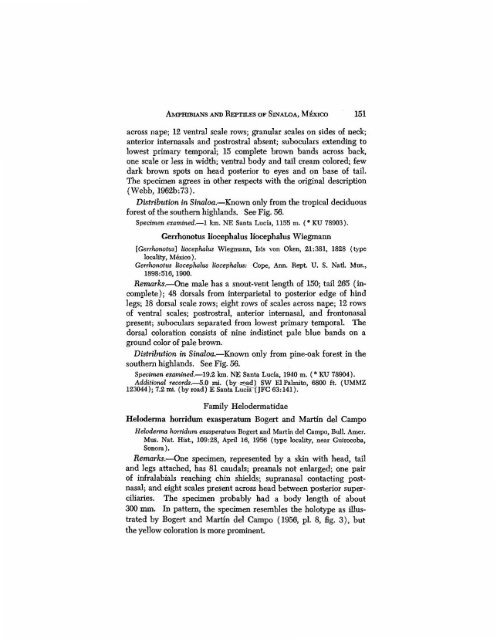The Amphibians and Reptiles of Sinaloa, Mexico - Smithsonian ...
The Amphibians and Reptiles of Sinaloa, Mexico - Smithsonian ...
The Amphibians and Reptiles of Sinaloa, Mexico - Smithsonian ...
Create successful ePaper yourself
Turn your PDF publications into a flip-book with our unique Google optimized e-Paper software.
AMPHIBIANS AND REPTILES OF SINALOA, MEXICO 151<br />
across nape; 12 ventral scale rows; granular scales on sides <strong>of</strong> neck;<br />
anterior intemasals <strong>and</strong> postrostral absent; suboculars extending to<br />
lowest primary temporal; 15 complete brown b<strong>and</strong>s across back,<br />
one scale or less in width; ventral body <strong>and</strong> tail cream colored; few<br />
dark brown spots on head posterior to eyes <strong>and</strong> on base <strong>of</strong> tail.<br />
<strong>The</strong> specimen agrees in other respects with the original description<br />
(Webb, 1962b: 73).<br />
Distribution in <strong>Sinaloa</strong>.—Known only from the tropical deciduous<br />
forest <strong>of</strong> the southern highl<strong>and</strong>s. See Fig. 56.<br />
Specimen examined.—1 km. NE Santa Lucia, 1155 m. ( e KU 78903).<br />
Cerrhonotus liocephalus liocephalus Wiegmann<br />
[Gerrhonotus] liocephalus Wiegmann, Isis von Olcen, 21:381, 1828 (type<br />
locality, <strong>Mexico</strong>).<br />
Gerrhonotus liocephalus liocephalus: Cope, Ann. Rent. U. S, NaU. Mus.,<br />
1898:518,1900.<br />
Remarks.—One male has a snout-vent length <strong>of</strong> 150; tail 265 (incomplete);<br />
48 dorsals from interparietal to posterior edge <strong>of</strong> hind<br />
legs; 18 dorsal scale rows; eight rows <strong>of</strong> scales across nape; 12 rows<br />
<strong>of</strong> ventral scales; postrostral, anterior internasal, <strong>and</strong> frontonasal<br />
present; suboculars separated from lowest primary temporal. <strong>The</strong><br />
dorsal coloration consists <strong>of</strong> nine indistinct pale blue b<strong>and</strong>s on a<br />
ground color <strong>of</strong> pale brown.<br />
Distribution in <strong>Sinaloa</strong>.—Known only from pine-oak forest in the<br />
southern highl<strong>and</strong>s. See Fig. 56.<br />
Specimen examined.—19.2 km. NE Santa Lucia, 1940 m. (*KU 78904).<br />
Additional records.—5.0 mi. (by rf>ad) SW ElFalmito, 6800 ft. (UMMZ<br />
123044}; 7.2 mi. (by road) E Santa Luciai JFC 63:141).<br />
Family Helodermatidae<br />
Heloderma horridum exasperatum Bogert <strong>and</strong> Martin del Campo<br />
Uehderma horridum exasperatum Bogert <strong>and</strong> Martin del Campo, Bull. Amer.<br />
Mus. Nat. Hist., 109:28, April 16, 1956 (type locality, near Guirocoba,<br />
Sonora),<br />
Remarks.—One specimen, represented by a skin with head, tail<br />
<strong>and</strong> legs attached, has 81 caudals; preanals not enlarged; one pair<br />
<strong>of</strong> infralabials reaching chin shields; supranasal contacting postnasal;<br />
<strong>and</strong> eight scales present across head between posterior superciliaries.<br />
<strong>The</strong> specimen probably had a body length <strong>of</strong> about<br />
300 mm. In pattern, the specimen resembles the holotype as illustrated<br />
by Bogert <strong>and</strong> Martin del Campo (1956, pi. 8, fig. 3), but<br />
the yellow coloration is more prominent.
















